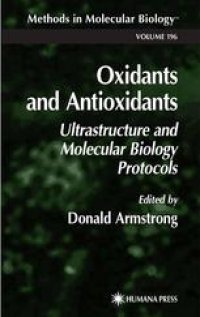
Ebook: Oxidants and Antioxidants: Ultrastructure and Molecular Biology Protocols
- Genre: Biology // Molecular
- Tags: Biochemistry general
- Series: Methods in Molecular Biology 196
- Year: 2002
- Publisher: Humana Press
- Edition: 1
- Language: English
- pdf
It is now feasible to identify subcellular sites where oxidative stress reactions occur and to determine gene expression relevant to those complex pathways. In Oxidants and Antioxidants: Ultrastructure and Molecular Biology Protocols, a panel of world authorities present cutting-edge molecular and ultrastructure techniques for investigating the pathophysiology of oxidative stress. Described in step-by-step detail, these readily reproducible methods use the latest in immunodetection, X-ray diffraction, confocal microscopy, in situ hybridization, chemiluminescence, and cytofluorescence. Additional techniques take advantage of electron paramagnetic resonance, advanced glycation endproducts, Western blotting analysis, transcription factors, p47phox translocation, and microsphere delivery systems. The collection emphasizes the visual observation of free radicals or products altered by oxidative stress, and includes numerous in vivo, ex vivo, and in vitro applications. Two companion volumes, Oxidative Stress Biomarkers and Antioxidant Protocols (2002), and Free Radical and Antioxidant Protocols (1998), focus on the related biochemical and cellular biological methods.
Authoritative and highly practical, Oxidants and Antioxidants: Ultrastructure and Molecular Biology Protocols provides a comprehensive collection of powerful ultrastructure and molecular tools for the evaluation of metabolic disorders linked to oxidative stress and the aging process.
In Oxidants and Antioxidants: Ultrastructural and Molecular Biology Protocols, a panel of world authorities present cutting-edge molecular and ultrastructure techniques for investigating the pathophysiology of oxidative stress. Described in step-by-step detail, these readily reproducible methods use the latest in immunodetection, X-ray diffraction, confocal microscopy, in situ hybridization, chemiluminescence, and cytofluorescence. Additional techniques take advantage of electron paramagnetic resonance, advanced glycation endproducts, Western blotting analysis, transcription factors, p47 phox translocation, and microsphere delivery systems. Two companion volumes, Oxidative Stress Biomarkers and Antioxidant Protocols (2002), and Free Radical and Antioxidant Protocols (1998), focus on the related biochemical and cellular biological methods.